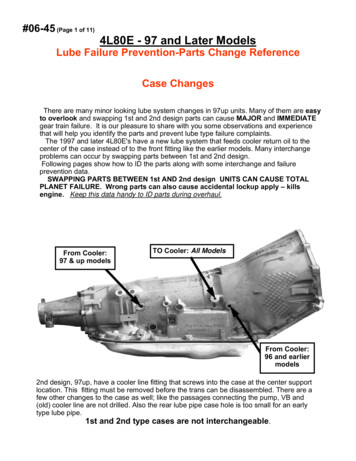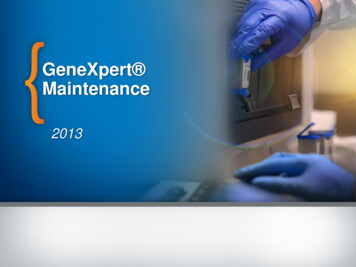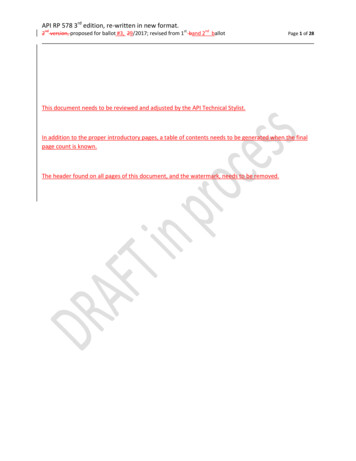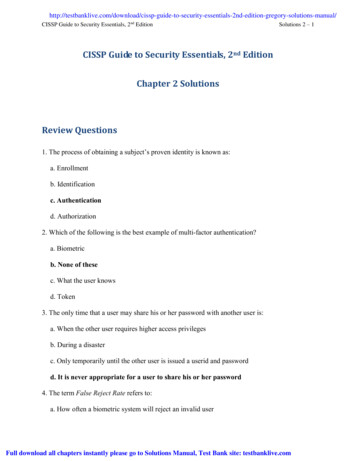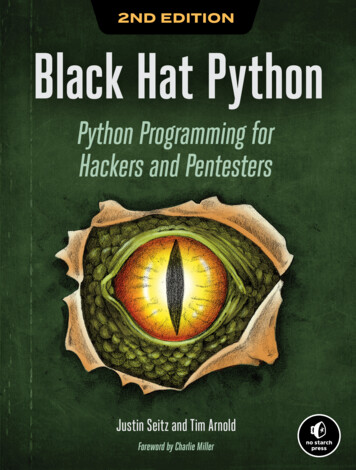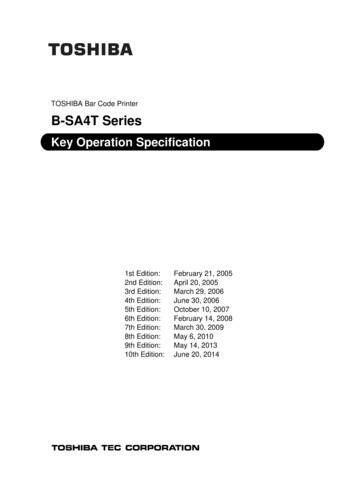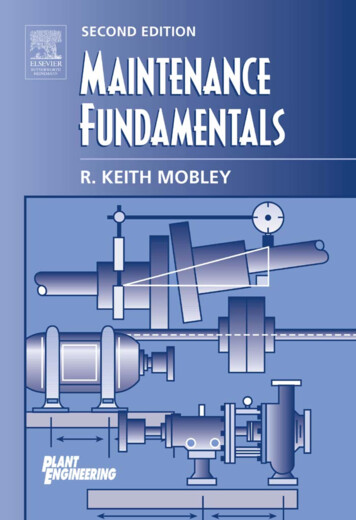
Transcription
MAINTENANCEFUNDAMENTALS2nd Edition
PLANT ENGINEERING MAINTENANCE SERIESVibration FundamentalsR. Keith MobleyRoot Cause Failure AnalysisR. Keith MobleyMaintenance FundamentalsR. Keith Mobley
MAINTENANCEFUNDAMENTALS2nd EditionR. Keith MobleyAMSTERDAM BOSTON HEIDELBERG LONDON NEW YORK OXFORDPARIS SAN DIEGO SAN FRANCISCO SINGAPORE SYDNEY TOKYO
Elsevier Butterworth–Heinemann200 Wheeler Road, Burlington, MA 01803, USALinacre House, Jordan Hill, Oxford OX2 8DP, UKCopyright # 2004, Elsevier Inc. All rights reserved.No part of this publication may be reproduced, stored in a retrieval system, or transmittedin any form or by any means, electronic, mechanical, photocopying, recording, orotherwise, without the prior written permission of the publisher.Permissions may be sought directly from Elsevier’s Science & Technology RightsDepartment in Oxford, UK: phone: (þ44) 1865 843830, fax: (þ44) 1865 853333,e-mail: permissions@elsevier.com.uk. You may also complete your request on-line via theElsevier homepage (http://elsevier.com), by selecting ‘‘Customer Support’’ and then‘‘Obtaining Permissions.’’Recognizing the importance of preserving what has been written, Elsevier prints its bookson acid-free paper whenever possible.Library of Congress Cataloging-in-Publication DataApplication submittedBritish Library Cataloguing-in-Publication DataA catalogue record for this book is available from the British Library.ISBN: 0-7506-7798-8For information on all Butterworth–Heinemann publicationsvisit our Web site at www.bh.com04 05 06 07 08 09 1010 9 8 7 6 5 4 3 2 1Printed in the United States of America
CONTENTSChapter 1Chapter ssaryIndexImpact of MaintenanceFundamental Requirements of EffectivePreventive MaintenanceDesigning a Preventive Maintenance ProgramPlanning and SchedulingScheduled Preventive MaintenanceMaintenance Engineering Roles and ResponsibilitiesShaft AlignmentRotor BalancingBearingsCouplingsGears and GearboxesCompressorsControl ValvesConveyorsFans, Blowers, and FluidizersDust CollectorsPumpsSteam TrapsPerformance Measurement and 331365374390416v
This page intentionally left blank
1IMPACT OF MAINTENANCEMaintenance costs, as defined by normal plant accounting procedures, arenormally a major portion of the total operating costs in most plants. Traditionalmaintenance costs (i.e., labor and material) in the United States have escalated ata tremendous rate over the past 10 years. In 1981, domestic plants spent morethan 600 billion to maintain their critical plant systems. By 1991, the costs hadincrease to more than 800 billion, and they were projected to top 1.2 trillion bythe year 2000. These evaluations indicate that on average, one third, or 250billion, of all maintenance dollars are wasted through ineffective maintenancemanagement methods. American industry cannot absorb the incredible level ofinefficiency and hope to compete in the world market.Because of the exorbitant nature of maintenance costs, they represent thegreatest potential short-term improvement. Delays, product rejects, scheduledmaintenance downtime, and traditional maintenance costs—such as labor,overtime, and repair parts—are generally the major contributors to abnormalmaintenance costs within a plant.The dominant reason for this ineffective management is the lack of factual datathat quantify the actual need for repair or maintenance of plant machinery,equipment, and systems. Maintenance scheduling has been and in many instances still is predicated on statistical trend data or on the actual failure ofplant equipment.Until recently, middle and corporate level management have ignored the impactof the maintenance operation on product quality, production costs, and moreimportantly on bottom-line profit. The general opinion has been ‘‘maintenance is1
2Maintenance Fundamentalsa necessary evil’’ or ‘‘nothing can be done to improve maintenance costs.’’Perhaps these were true statements 10 or 20 years ago. However, the developments of microprocessor or computer-based instrumentation that can be used tomonitor the operating condition of plant equipment, machinery, and systemshave provided the means to manage the maintenance operation. They haveprovided the means to reduce or eliminate unnecessary repairs, prevent catastrophic machine failures, and reduce the negative impact of the maintenanceoperation on the profitability of manufacturing and production plants.MAINTENANCE PHILOSOPHIESIndustrial and process plants typically utilize two types of maintenance management: (1) run-to-failure, or (2) preventive maintenance.Run-to-Failure ManagementThe logic of run-to-failure management is simple and straightforward. When amachine breaks, fix it. This ‘‘if it ain’t broke, don’t fix it’’ method of maintainingplant machinery has been a major part of plant maintenance operations since thefirst manufacturing plant was built, and on the surface sounds reasonable.A plant using run-to-failure management does not spend any money on maintenance until a machine or system fails to operate. Run-to-failure is a reactivemanagement technique that waits for machine or equipment failure before anymaintenance action is taken. It is in truth a no-maintenance approach ofmanagement. It is also the most expensive method of maintenance management.Few plants use a true run-to-failure management philosophy. In almost allinstances, plants perform basic preventive tasks (i.e., lubrication, machineadjustments, and other adjustments) even in a run-to-failure environment. However, in this type of management, machines and other plant equipment are notrebuilt nor are any major repairs made until the equipment fails to operate.The major expenses associated with this type of maintenance management are:(1) high spare parts inventory cost, (2) high overtime labor costs, (3) high machinedowntime, and (4) low production availability. Since there is no attempt toanticipate maintenance requirements, a plant that uses true run-to-failure management must be able to react to all possible failures within the plant. This reactivemethod of management forces the maintenance department to maintain extensivespare parts inventories that include spare machines or at least all major components for all critical equipment in the plant. The alternative is to rely on equipmentvendors that can provide immediate delivery of all required spare parts. Even if thelatter is possible, premiums for expedited delivery substantially increase the costs
Impact of Maintenance3of repair parts and downtime required for correcting machine failures. To minimize the impact on production created by unexpected machine failures, maintenance personnel must also be able to react immediately to all machine failures.The net result of this reactive type of maintenance management is higher maintenance cost and lower availability of process machinery. Analysis of maintenance costs indicates that a repair performed in the reactive or run-to-failuremode will average about three times higher than the same repair made within ascheduled or preventive mode. Scheduling the repair provides the ability tominimize the repair time and associated labor costs. It also provides the meansof reducing the negative impact of expedited shipments and lost production.Preventive Maintenance ManagementNumber of failuresThere are many definitions of preventive maintenance, but all preventive maintenance management programs are time driven. In other words, maintenancetasks are based on elapsed time or hours of operation. Figure 1.1 illustrates anexample of the statistical life of a machine-train. The mean time to failure (MTTF)or bathtub curve indicates that a new machine has a high probability of failure,because of installation problems, during the first few weeks of operation. Afterthis initial period, the probability of failure is relatively low for an extended periodof time. Following this normal machine life period, the probability of failureincreases sharply with elapsed time. In preventive maintenance management,machine repairs or rebuilds are scheduled on the basis of the MTTF statistic.Break inorstart upNormal lifeTimeFigure 1.1 Bathtub curve.Equipmentworn out
4Maintenance FundamentalsThe actual implementation of preventive maintenance varies greatly. Someprograms are extremely limited and consist of lubrication and minor adjustments. More comprehensive preventive maintenance programs schedule repairs,lubrication, adjustments, and machine rebuilds for all critical machinery in theplant. The common denominator for all of these preventive maintenance programs is the scheduling guideline. All preventive maintenance managementprograms assume that machines will degrade within a time frame typical of itsparticular classification. For example, a single-stage, horizontal split-case centrifugal pump will normally run 18 months before it must be rebuilt. Whenpreventive management techniques are used, the pump would be removed fromservice and rebuilt after 17 months of operation.The problem with this approach is that the mode of operation and system orplant-specific variables directly affect the normal operating life of machinery.The mean time between failures (MTBF) will not be the same for a pump that ishandling water and one that is handling abrasive slurries. The normal result ofusing MTBF statistics to schedule maintenance is either unnecessary repairs orcatastrophic failure. In the example, the pump may not need to be rebuilt after 17months. Therefore the labor and material used to make the repair was wasted.The second option, use of preventive maintenance, is even more costly. If thepump fails before 17 months, we are forced to repair by using run-to-failuretechniques. Analysis of maintenance costs has shown that a repair made in areactive mode (i.e., after failure) will normally be three times greater than thesame repair made on a scheduled basis.Predictive MaintenanceLike preventive maintenance, predictive maintenance has many definitions. Tosome, predictive maintenance is monitoring the vibration of rotating machineryin an attempt to detect incipient problems and to prevent catastrophic failure. Toothers, it is monitoring the infrared image of electrical switchgears, motors, andother electrical equipment to detect developing problems.The common premise of predictive maintenance is that regular monitoring ofthe mechanical condition of machine-trains will ensure the maximum intervalbetween repair and minimize the number and cost of unscheduled outagescreated by machine-train failures. Predictive maintenance is much more. It isthe means of improving productivity, product quality, and overall effectivenessof our manufacturing and production plants. Predictive maintenance is notvibration monitoring or thermal imaging or lubricating oil analysis or any ofthe other nondestructive testing techniques that are being marketed as predictivemaintenance tools. Predictive maintenance is a philosophy or attitude that,simply stated, uses the actual operating condition of plant equipment and
Impact of Maintenance5systems to optimize total plant operation. A comprehensive predictive maintenance management program utilizes a combination of the most cost-effectivetools—that is, vibration monitoring, thermography, tribology, etc.—to obtainthe actual operating condition of critical plant systems, and based on these actualdata, schedules all maintenance activities on an as-needed basis. Includingpredictive maintenance in a comprehensive maintenance management programwill provide the ability to optimize the availability of process machinery andgreatly reduce the cost of maintenance. It will also provide the means to improveproduct quality, productivity, and profitability of our manufacturing andproduction plants.Predictive maintenance is a condition-driven preventive maintenance program.Instead of relying on industrial or in-plant average-life statistics (i.e., MTTF) toschedule maintenance activities, predictive maintenance uses direct monitoringof the mechanical condition, system efficiency, and other indicators to determinethe actual MTTF or loss of efficiency for each machine-train and system in theplant. At best, traditional time-driven methods provide a guideline to normalmachine-train life spans. The final decision, in preventive or run-to-failureprograms, on repair or rebuild schedules must be made on the bases of intuitionand the personal experience of the maintenance manager. The addition of acomprehensive predictive maintenance program can and will provide factualdata on the actual mechanical condition of each machine-train and operatingefficiency of each process system. These data provide the maintenance managerwith actual data for scheduling maintenance activities.A predictive maintenance program can minimize unscheduled breakdowns of allmechanical equipment in the plant and ensure that repaired equipment is inacceptable mechanical condition. The program can also identify machine-trainproblems before they become serious. Most mechanical problems can be minimized if they are detected and repaired early. Normal mechanical failure modesdegrade at a speed directly proportional to their severity. If the problem isdetected early, major repairs, in most instances, can be prevented. Simple vibration analysis is predicated on two basic facts: all common failure modes havedistinct vibration frequency components that can be isolated and identified, andthe amplitude of each distinct vibration component will remain constant unlessthere is a change in the operating dynamics of the machine-train. These facts,their impact on machinery, and methods that will identify and quantify the rootcause of failure modes will be developed in more detail in later chapters.Predictive maintenance that utilizes process efficiency, heat loss, or other nondestructive techniques can quantify the operating efficiency of non-mechanicalplant equipment or systems. These techniques used in conjunction with vibrationanalysis can provide the maintenance manager or plant engineer with factual
6Maintenance Fundamentalsinformation that will enable him to achieve optimum reliability and availabilityfrom the plant.There are five nondestructive techniques normally used for predictive maintenance management: (1) vibration monitoring, (2) process parameter monitoring,(3) thermography, (4) tribology, and (5) visual inspection. Each technique has aunique data set that will assist the maintenance manager in determining theactual need for maintenance. How do you determine which technique or techniques are required in your plant? How do you determine the best method toimplement each of the technologies? If you listen to the salesman for the vendorsthat supply predictive maintenance systems, his is the only solution to yourproblem. How do you separate the good from the bad? Most comprehensivepredictive maintenance programs will use vibration analysis as the primary tool.Since the majority of normal plant equipment is mechanical, vibration monitoring will provide the best tool for routine monitoring and identification of incipient problems. However, vibration analysis will not provide the data required onelectrical equipment, areas of heat loss, condition of lubricating oil, or otherparameters that should be included in your program.ROLE OF MAINTENANCE ORGANIZATIONToo many maintenance organizations continue to pride themselves on how fastthey can react to a catastrophic failure or production interruption rather than ontheir ability to prevent these interruptions. While few will admit their continuedadherence to this breakdown mentality, most plants continue to operate in thismode. Contrary to popular belief, the role of the maintenance organization is tomaintain plant equipment, not to repair it after a failure.The mission of maintenance in a world-class organization is to achieve andsustain optimum availability.Optimum AvailabilityThe production capacity of a plant is, in part, determined by the availability ofproduction systems and their auxiliary equipment. The primary function of themaintenance organization is to ensure that all machinery, equipment, andsystems within the plant are always on line and in good operating condition.Optimum Operating ConditionAvailability of critical process machinery is not enough to ensure acceptableplant performance levels. The maintenance organization has the responsibility to
Impact of Maintenance7maintain all direct and indirect manufacturing machinery, equipment, andsystems so that they will be continuously in optimum operating condition.Minor problems, no matter how slight, can result in poor product quality, reduceproduction speeds, or affect other factors that limit overall plant performance.Maximum Utilization of Maintenance ResourcesThe maintenance organization controls a substantial part of the total operatingbudget in most plants. In addition to an appreciable percentage of the total plantlabor budget, the maintenance manager, in many cases, controls the spare partsinventory, authorizes the use of outside contract labor, and requisitions millionsof dollars in repair parts or replacement equipment. Therefore, one goal of themaintenance organization should be the effective use of these resources.Optimum Equipment LifeOne way to reduce maintenance cost is to extend the useful life of plant equipment. The maintenance organization should implement programs that will increase the useful life of all plant assets.Minimum Spares InventoryReductions in spares inventory should be a major objective of the maintenanceorganization. However, the reduction cannot impair their ability to meet goals1 through 4. With the predictive maintenance technologies that are availabletoday, maintenance can anticipate the need for specific equipment or parts farenough in advance to purchase them on an as-needed basis.Ability to React QuicklyNot all catastrophic failures can be avoided. Therefore the maintenance organization must maintain the ability to react quickly to the unexpected failure.EVALUATION OF THE MAINTENANCE ORGANIZATIONOne means to quantify the maintenance philosophy in your plant is to analyzethe maintenance tasks that have occurred over the past two to three years.Attention should be given to the indices that define management philosophy.One of the best indices of management attitude and the effectiveness of themaintenance function is the number of production interruptions caused bymaintenance-related problems. If production delays represent more than 30%
8Maintenance Fundamentalsof total production hours, reactive or breakdown response is the dominantmanagement philosophy. To be competitive in today’s market, delays causedby maintenance-related problems should represent less than 1% of the totalproduction hours.Another indicator of management effectiveness is the amount of maintenanceovertime required to maintain the plant. In a breakdown maintenance environment, overtime cost is a major negative cost. If your maintenance department’sovertime represents more than 10% of the total labor budget, you definitely qualifyas a breakdown operation. Some overtime is and will always be required. Specialprojects and the 1% of delays caused by machine failures will force some expenditure of overtime premiums, but these abnormal costs should be a small percentageof the total labor costs. Manpower utilization is another key to managementeffectiveness. Evaluate the percentage of maintenance labor as compared withtotal available labor hours that are expended on the actual repairs and maintenance prevention tasks. In reactive maintenance management, the percentage willbe less than 50%. A well-managed maintenance organization should maintainconsistent manpower utilization above 90%. In other words, at least 90% of theavailable maintenance labor hours should be effectively utilized to improve thereliability of critical plant systems, not waiting on something to break.Three Types of MaintenanceThere are three main types of maintenance and three major divisions of preventive maintenance, as illustrated in Figure 1.2.Maintenance ImprovementPicture these divisions as the five fingers on your hand. Improvement maintenance efforts to reduce or eliminate the need for maintenance are like the thumb,the first and most valuable digit. We are often so involved in maintaining that weforget to plan and eliminate the need at its source. Reliability engineering effortsshould emphasize elimination of failures that require maintenance. This is anopportunity to pre-act instead of react.For example, many equipment failures occur at inboard bearings that are locatedin dark, dirty, inaccessible locations. The oiler does not lubricate inaccessiblebearings as often as he lubricates those that are easy to reach. This is a naturaltendency. One can consider reducing the need for lubrication by using permanently lubricated, long-life bearings. If that is not practical, at least an automaticoiler could be installed. A major selling point of new automobiles is the elimination of ignition points that require replacement and adjustment, introduction ofself-adjusting brake shoes and clutches, and extension of oil change intervals.
Impact of drivenModificationRetrofitRedesignChange achine-cuedControl limitsWhen deficientAs requiredPredictiveStatistical analysisTrendsVibration monitoringTribologyThermographyUltrasonicsOther NDTCORRECTIVE(CM)Time-drivenPeriodicFixed intervalsHard time limitsSpecific RebuildsFigure 1.2 Structure of maintenance.Corrective MaintenanceThe little finger in our analogy to a human hand represents corrective maintenance(emergency, repair, remedial, unscheduled). At present, most maintenance iscorrective. Repairs will always be needed. Better improvement maintenance andpreventive maintenance, however, can reduce the need for emergency corrections.A shaft that is obviously broken into pieces is relatively easy to maintain becauselittle human decision is involved. Troubleshooting and diagnostic fault detectionand isolation are major time consumers in maintenance. When the problem isobvious, it can usually be corrected easily. Intermittent failures and hidden defectsare more time consuming, but with diagnostics, the causes can be isolated and thencorrected. From a preventive maintenance perspective, the problems and causesthat result in failures provide the targets for elimination by viable preventivemaintenance. The challenge is to detect incipient problems before they lead tototal failures and to correct the defects at the lowest possible cost. That leads usto the middle three fingers the branches of preventive maintenance.Preventive MaintenanceAs the name implies, preventive maintenance tasks are intended to prevent unscheduled downtime and premature equipment damage that would result incorrective or repair activities. This maintenance management approach is predominately a time-driven schedule or recurring tasks, such as lubrication and adjustments that are designed to maintain acceptable levels of reliability and availability.
10Maintenance FundamentalsReactive MaintenanceReactive maintenance is done when equipment needs it. Inspection with humansenses or instrumentation is necessary, with thresholds established to indicatewhen potential problems start. Human decisions are required to establish thosestandards in advance so that inspection or automatic detection can determinewhen the threshold limit has been exceeded. Obviously, a relatively slow deterioration before failure is detectable by condition monitoring, whereas rapid, catastrophic modes of failure may not be detected. Great advances in electronics andsensor technology are being made.Also needed is a change in the human thought process. Inspection and monitoring should include disassembly of equipment only when a problem is detected.The following are general rules for on-condition maintenance: Inspect critical components.Regard safety as paramount.Repair defects.If it works, don’t fix it.Condition MonitoringStatistics and probability theory provide are the bases for condition monitormaintenance. Trend detection through data analysis often rewards the analystwith insight into the causes of failure and preventive actions that will help avoidfuture failures. For example, stadium lights burn out within a narrow range oftime. If 10% of the lights have burned out, it may be accurately assumed that therest will fail soon and should, most effectively, be replaced as a group rather thanindividually.Scheduled MaintenanceScheduled, fixed-interval preventive maintenance tasks should generally be usedonly if there is opportunity for reducing failures that cannot be detected inadvance, or if dictated by production requirements. The distinction should bedrawn between fixed-interval maintenance and fixed-interval inspection that maydetect a threshold condition and initiate condition monitor tasks. Examples offixed interval tasks include 3,000-mile oil changes and 48,000-mile spark plugchanges on a car, whether it needs the changes or not. This may be very wasteful,because all equipment and their operating environments are not alike. What isright for one situation may not be right for another.
2FUNDAMENTAL REQUIREMENTSOF EFFECTIVE PREVENTIVEMAINTENANCEWhen most people think of preventive maintenance, they visualize scheduled,fixed-interval maintenance that is done every day, every month, every quarter,every season, or at some other predetermined interval. Timing may be based ondays or on intervals such as miles, gallons, activations, or hours of use. The useof performance intervals is itself a step toward basing preventive tasks on actualneed instead of just on a generality.The two main elements of fixed-interval preventive maintenance are procedureand discipline. Procedure means that the correct tasks are done and the rightlubricants applied and consumables replaced at the best interval. Disciplinerequires that all the tasks are planned and controlled so that everything is donewhen it should be done. Both of these areas deserve attention. The topic ofprocedures is covered in detail in the following sections.Discipline is a major problem in many organizations. This is obvious when oneconsiders the fact that many organizations do not have an established program.Further, organizations that do claim to have a program often fail to establish agood planning and control procedure to ensure accomplishment. Elements ofsuch a procedure include:1. Listing of all equipment and the intervals at which it must receive PMs2. A master schedule for the year that breaks down tasks by month,week, and possibly even to the day11
12Maintenance Fundamentals3. Assignment of responsible persons to do the work4. Inspection by the responsible supervisor to make sure that qualitywork is done on time5. Updating of records to show when the work was done and when thenext preventive task is due6. Follow-up as necessary to correct any discrepancies.Fundamental Requirements of Effective MaintenanceEffective maintenance is not magic, nor is it dependent on exotic technologiesor expensive instruments or systems. Instead, it is dependent on doing simple, basictasks that will result in reliable plant systems. These basics include the following.InspectionsCareful inspection, which can be done without ‘‘tearing down’’ the machine,saves both technician time and exposure of the equipment to possible damage.Rotating components find their own best relationship to surrounding components. For example, piston rings in an engine or compressor cylinder quickly wearto the cylinder wall configuration. If they are removed for inspection, the chancesare that they will not easily fit back into the same pattern. As a result, additionalwear will occur and the rings will have to be replaced much sooner than ifthey were left intact and performance-tested for pressure produced and metalparticles in the lubricating oil.Human SensesWe humans have a great capability for sensing unusual sights, sounds, smells,tastes, vibrations, and touches. Every maintenance manager should make aconcerted effort to increase the sensitivity of his own and that of his personnel’shuman senses. Experience is generally the best teacher. Often, however, weexperience things without knowing what we are experiencing. A few hours oftraining in what to look for could have high payoff.Human senses are able to detect large differences but are generally not sensitiveto small changes. Time tends to have a dulling effect. Have you ever tried todetermine if one color is the same as another without having a sample of eachto compare side by side? If you have, you will understand the need for standards.A standard is any example that can be compared with the existing situation as ameasurement. Quantitative specifications, photographs, recordings, and actualsamples should be provided. The critical parameters should be clearly marked onthem with a display as to what is good and what is bad.
Fundamental Requirements of Effective Preventive Maintenance13As the reliability-based preventive maintenance program develops, samplesshould be collected that will help to pinpoint with maximum accuracy howmuch wear can take place before problems will occur. A display where craftsmengather can be effective. A framed 4-foot by 4-foot pegboard works well sinceshafts, bearings, gears, and other components can be easily wired to it or hung onhooks for display. An effective but little-used display area where notices can beposted is above the urinal or on the
maintenance downtime, and traditional maintenance costs—such as labor, overtime, and repair parts—are generally the major contributors to abnormal maintenance costs within a plant. The dominan

